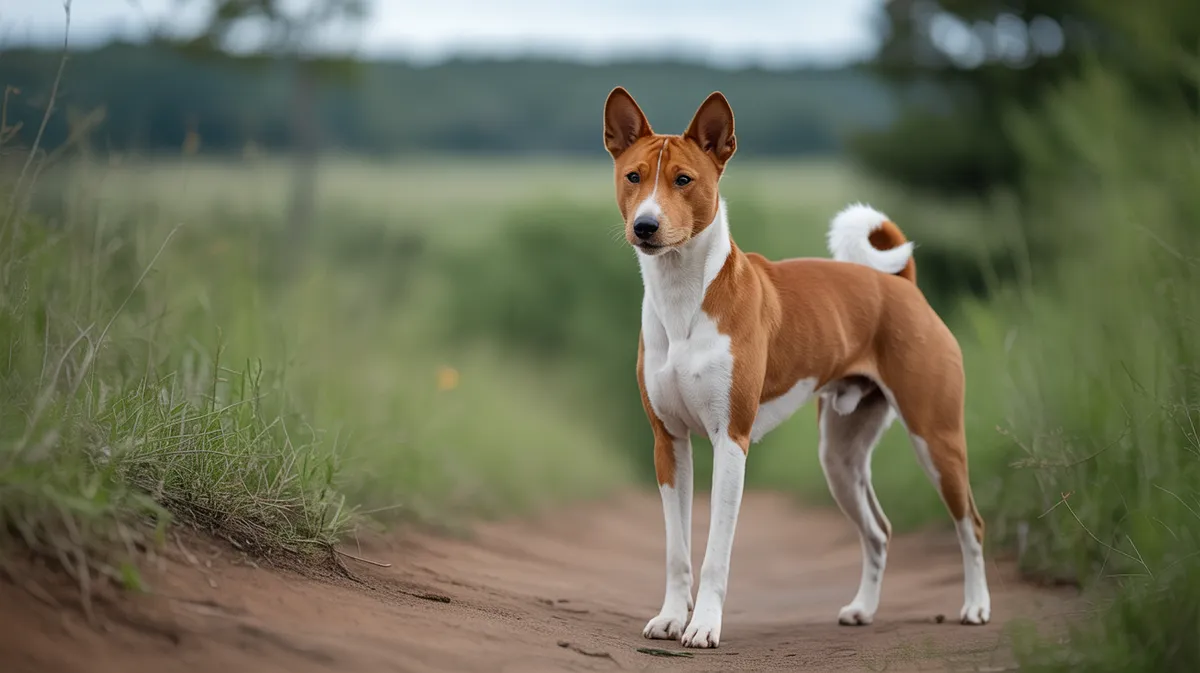
Basenji
Canis lupus familiaris

Meet the Basenji
The Basenji is a small to medium-sized dog breed known for its elegant, athletic build and unique behaviors. Originating from Central Africa, it was traditionally used for hunting due to its keen sight, agility, and speed. Basenjis are famous for their inability to bark, instead producing a distinctive yodel known as a 'barroo.' With their short, fine coat, tightly curled tail, and expressive almond-shaped eyes, Basenjis are both intelligent and independent, often forming strong bonds with their families. They are curious, energetic, and require regular physical and mental stimulation.
Classification
Mammal
Habitat
Savanna and forest regions near human settlements
Diet
Omnivore
Lifespan
12-16 years
Conservation
Least Concern
Weight
9–12 kg (20–26 lbs)
📖Fascinating Facts
Barkless Communication
Basenjis cannot bark like other dogs due to the unique structure of their larynx, but they communicate with a yodel-like sound called a 'barroo.'
Cat-like Cleanliness
Basenjis have a strong instinct to groom themselves, often licking their coats much like cats to stay clean.
Natural Hunters
Originally bred in Central Africa, Basenjis were used for hunting small game, relying on their keen eyesight, speed, and agility.
📋Detailed Description
The Basenji is a small, finely built dog breed with a distinctive, athletic physique, standing 40–43 cm (16–17 in) at the shoulder and weighing 9.5–11 kg (21–24 lbs). Its short, fine coat comes in several colorations, including red, black, tricolor, and brindle, always with white markings on the feet, chest, and tail tip. The breed is noted for its tightly curled tail, high-set ears, and almond-shaped, expressive eyes, which contribute to its alert and intelligent appearance. Anatomically, the Basenji has a uniquely structured larynx, which prevents it from barking like other dogs; instead, it produces a yodel-like sound called a 'barroo.' Basenjis are highly energetic, with a lean musculature adapted for rapid acceleration and endurance, traits honed by generations of hunting in dense African forests and savannas. They are known for their fastidious grooming habits, often compared to those of cats, and their minimal doggy odor. Socially, Basenjis are independent yet form close bonds with their human families, displaying both affection and a strong-willed temperament. In the wild or traditional village settings, they often work in small packs, demonstrating complex social interactions and cooperative hunting strategies. Their intelligence and curiosity make them adept problem-solvers, but also prone to boredom if not sufficiently stimulated. Basenjis are generally long-lived, with a typical lifespan of 14–16 years, and are considered robust, though they are predisposed to certain hereditary conditions such as Fanconi syndrome.
💡 Did you know?
Unlike most dog breeds, female Basenjis come into heat only once a year, similar to wild canids.
🔬Research & Sources
Wikipedia Summary
The Basenji is a breed of hunting dog created from stock that originated in Central Africa, including in the Republic of the Congo and other adjacent tropical African countries. The Fédération Cynologique Internationale places the Basenji in the Spitz and "primitive types" categories, while the American Kennel Club classifies it as a hound. The breed does not bark in the traditional manner of most dogs, rather vocalising in an unusual, yodel-like "talking" sound, due to its unusually-shaped larynx. This trait earns the Basenji its nickname of "barkless" dog, a similar feature seen and heard in the New Guinea singing dog.
Last Modified: 6/11/2025
🎭Behavior & Social Structure
Basenjis are highly alert, inquisitive, and active dogs, displaying a strong prey drive and keen sight and scent abilities. Historically, they hunted small game such as rodents and birds, often working in coordinated groups to flush and corner prey. Their hunting style relies on both sight and scent, and they are known for their silent stalking and sudden bursts of speed. Basenjis are crepuscular, being most active at dawn and dusk, which aligns with the activity patterns of their prey in the wild. They are independent thinkers, often making decisions autonomously, but can be affectionate and playful with their families. Social interactions among Basenjis involve complex body language and vocalizations, including the characteristic yodel, growls, and whines. They are territorial and may be reserved with strangers, but generally coexist peacefully with other dogs if socialized early. Basenjis are known for their cleanliness, spending significant time grooming themselves and each other. Their daily routines require significant physical and mental stimulation; without it, they may develop destructive behaviors or attempt to escape enclosed spaces.
👶Reproduction & Life Cycle
Basenjis exhibit a unique reproductive cycle among domestic dogs, with females typically coming into estrus only once per year, usually in the autumn, which is a trait shared with their wild canid relatives. Mating is often preceded by elaborate courtship behaviors, including mutual grooming, play, and vocalizations. The gestation period lasts approximately 63 days, after which litters of 4–6 puppies are born. Basenji mothers are attentive, providing extensive care, grooming, and protection for their young. Puppies are born blind and helpless, opening their eyes at around two weeks of age. Weaning begins at about four weeks, with full independence reached by 8–10 weeks. Both parents may participate in socializing and protecting the litter in traditional village environments, though in domestic settings, the female is the primary caregiver. Selective breeding has been used to maintain genetic diversity and reduce the incidence of inherited disorders.
🛡️Adaptations & Survival
The Basenji's physical and behavioral adaptations are a product of its evolution as a hunting dog in the dense forests and savannas of Central Africa. Its compact, muscular build allows for agile movement through underbrush, while its keen eyesight and acute sense of smell aid in detecting prey. The breed's unique laryngeal structure prevents barking, which may have been advantageous for silent hunting and avoiding detection by predators or prey. The tightly curled tail and erect ears enhance communication and alertness. Basenjis have a high tolerance for heat and humidity, a trait developed in response to their tropical origins. Their fastidious grooming and low odor are likely adaptations to reduce scent signatures in the wild. Behaviorally, their independence, intelligence, and problem-solving skills are essential for surviving and hunting in challenging environments.
📚Research Sources
🎨Cultural Significance
The Basenji holds significant cultural value among various Central African peoples, notably the Azande and Mangbetu tribes, who have used the breed for centuries as hunting companions and village watchdogs. Known locally as the 'Congo dog' or 'Zande dog,' Basenjis were prized for their intelligence, silence, and ability to navigate dense forests. They appear in traditional folklore and are sometimes associated with spiritual beliefs, symbolizing agility, cleverness, and loyalty. In Western culture, the Basenji has gained popularity for its unique vocalizations and elegant appearance, often featured in dog shows and as a companion animal. The breed's 'barkless' nature has contributed to its mystique and enduring appeal.
🔬Recent Research & Discoveries
Recent genetic studies have confirmed the Basenji's status as one of the most ancient and genetically distinct dog breeds, with mitochondrial DNA analyses showing close relationships to other African village dogs and primitive breeds like the New Guinea singing dog and Australian dingo. Ongoing research focuses on the breed's unique vocalization mechanism, with anatomical studies revealing specialized laryngeal structures. Advances in veterinary genetics have led to improved screening for hereditary diseases such as Fanconi syndrome, allowing breeders to reduce the prevalence of these conditions. Ethological studies continue to explore the Basenji's problem-solving abilities, social behaviors, and adaptability to modern environments. Conservation genetics projects in Africa aim to document and preserve native Basenji populations, ensuring the survival of their unique genetic heritage.
🎥Wildlife Videos

Basenji vs Whippet: #Basenji #Whippet #DogBreeds #CanineShowdown #DogLovers #WildlifeDocumentary
Basenji vs Whippet: #Basenji #Whippet #DogBreeds #CanineShowdown #DogLovers #WildlifeDocumentary ...
Animals World.official

Wild India - Fantastic Creatures | Free Documentary Nature
Wild India - Fantastic Creatures | Free Documentary Nature Watch 'Wild Madagascar - Fantastic Creatures' here: ...
Free Documentary - Nature

Wild Canada - Nature's Untamed Beauty | Full Series | Free Documentary Nature
Wild Canada - Nature's Untamed Beauty | Wildlife Documentary Watch 'Darkwoods - Canada's Hidden Nature Reserve' here: ...
Free Documentary - Nature

Surviving 24 Hours In The Jungle | Wildlife Documentary
Embark on a journey through the diverse and dangerous landscapes of India, New Zealand and Brazil, showcasing the intense ...
All Out Wildlife

The Unique Wildlife of Brazil’s Rainforest
Explore the incredible biodiversity and unique ecosystems of Brazil's Mata Atlântica and other regions. The show delves into the ...
Real Wild

30 Most Beautiful Creatures On Earth (Order Galliformes) | Wildlife Documentary | BBTV Official
In the heart of the world's most remote forests and rugged highlands, where mist lingers over ancient trees and the wilderness ...
BBTV Official
🌍Habitat Information
The Basenji typically inhabits Savanna and forest regions near human settlements environments. Basenjis have adapted to their environments with specialized features and behaviors.
Primary Habitat:
Savanna and forest regions near human settlements
More detailed habitat information will be available soon.
🛡️Conservation Status
The Basenji is currently classified as Least Concern. Conservation efforts are crucial for preserving this species for future generations.
Common Threats:
- 🏠Habitat loss and fragmentation
- 🌡️Climate change impacts
- 🎯Hunting and poaching
- 🏭Human-wildlife conflict
⚠️Threats & Conservation Challenges
In their native regions, Basenjis face threats from habitat loss, disease, and interbreeding with other local dogs, which can dilute breed characteristics. While the breed is not considered at risk globally, populations in Africa may be declining due to changing land use and reduced reliance on traditional hunting dogs. In developed countries, the main challenges are genetic health issues, such as Fanconi syndrome, progressive retinal atrophy, and pyruvate kinase deficiency, which are managed through responsible breeding programs. Human impact, including the demand for exotic pets and changes in rural lifestyles, has influenced both the breed's distribution and genetic diversity. Conservation efforts focus on maintaining genetic health and preserving the breed's unique characteristics through international collaboration and careful breeding.
🔬Scientific Classification
Scientific Name
Canis lupus familiaris
Classification Hierarchy
🔍 About Taxonomic Classification
Taxonomic classification is a hierarchical system used by scientists to classify and organize living organisms based on shared characteristics and evolutionary relationships.
The system moves from broad categories (Kingdom) to increasingly specific ones, with each animal's scientific name typically consisting of its Genus and species.
📝Community Notes
Share your observations and insights about the Basenji with our community of wildlife enthusiasts.
Join Our Community
Sign in to share your observations and connect with fellow wildlife enthusiasts.
Sign In to ContributeNo community notes yet
Be the first to share your observations about the Basenji!
Explore Basenji
Select a tab above to learn more about this amazing animal.
📸Photo Gallery
No photos available for this animal yet.
🌟Discover More Wildlife
Continue your journey of discovery with more fascinating animals from our database
